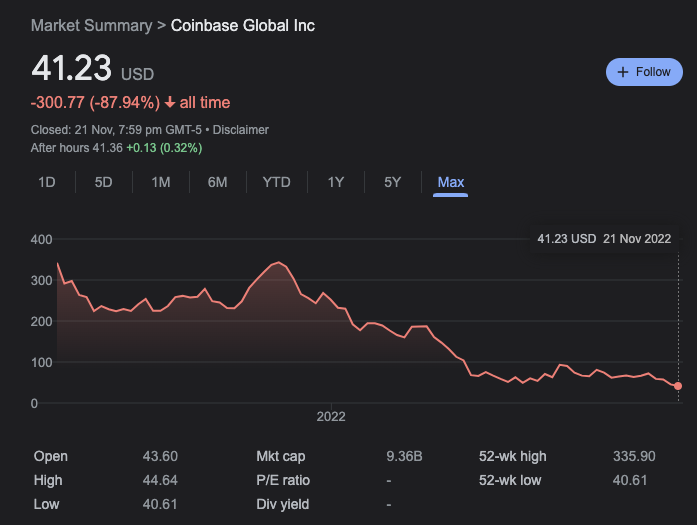Table of Contents
It might come as no surprise that Coinbase (COIN) is suffering immensely amid crypto winter and the recent FTX fallout. Sinking as low as US$40.61 on Monday, Coinbase hit its lowest ever price, down over 85% YTD – certainly a far cry from the exchange’s all time high of US$429.53 in April 2021.

Coinbase’s decline is largely in sync with the wider crypto market, with both bitcoin and ethereum falling over 70% YTD too. However, Coinbase’s deeper dive suggests there’s more at play to the exchange’s troubles.
As a listed company, Coinbase’s financial health (or lack there of) is available for everyone to view. In their most recent quarter, Coinbase revealed its revenue plummeted over 50% from the prior year to US$590 million, falling short of analysts expectations of US$654 million.
Clocking in a loss of US$545 million, Coinbase cited “stronger macroeconomic and crypto market headwinds” for their weakened revenue. Retail transaction revenue was down US$1.02 billion from the previous year to US$346.1 million, short of the analyst target of US$454.2 million.
Its user base has also been on the decline, totalling 8.5 million monthly transacting users, down from 9 million in the prior quarter. That said, analysts had only been expecting 7.84 million.
Just last month, received an in-principal approval from the Monetary Authority of Singapore (MAS) to provide digital payment token (DPT) services in the country, joining a dozen or so others to hold the coveted crypto license in the city-state.
Alonebase
Coinbase is the only listed crypto exchange for the public to do their due dilligence on. Sure, Robinhood offers crypto services, but it operates primarily for stock traders. Because of this, we can use Coinbase’s numbers as a measure of how other crypto exchanges might be faring.
Crypto.com CEO Kris Marszalek recently attempted to reassure concerned users that the company had a “tremendously strong balance sheet”, but without it being a publicly listed company, we have no way of seeing it for ourselves. So, all eyes on Coinbase for now.
Over the weekend, Coinbase CEO Brian Armstrong reassured the market that he is just as bullish on crypto as ever,” stating what happened at FTX would “never happen” at Coinbase, describing it as “one bad actor.”
He added that when the tide goes out, “you can see who’s swimming naked,” which serves as a perfect analogy for the transparency offered by Coinbase as a listed company.
Read more: Coinbase CEO Knew “Alameda was Printing Money in the Bahamas”
Patterns from Coinbase’s financials that could be mirrored in other crypto exchanges include user behaviour. As stated, monthly transacting users have been on the decline at Coinbase, but were still higher than expected. This could be a reflection of crypto winter taking its toll on market participants not willing to trade during this period. It is most likely not the only exchange seeing less activity and its better-than-expected figures could also be shared by others.
Another interesting stat from Coinbase’s financials is that Ethereum trading increased from 22% to 33%, suggesting that market participants are using CeFi, or centralized finance, means to store ETH. Other exchanges could be seeing similar patterns. That said, only 24% of transaction revenue came from Ethereum, suggesting other altcoins are still popular on centralised exchanges.
COINtagion
On Friday, Bank of America downgraded Coinbase from a “buy” to “neutral,” citing “contagion risk” following the FTX fallout.
“We think Coinbase (COIN) likely faces a number of new headwinds over the near/medium-term due to the recent collapse of rival crypto exchange FTX,” analyst Jason Kupferberg wrote in a note Friday. “We feel confident that COIN is not ‘another FTX’, but that does not make them immune from the broader fallout within the crypto ecosystem.”
These concerns are certainly applicable to other crypto exchanges. Kupferberg said he expected lower trading from retail traders in light of FTX, which again would be true for other exchanges.
Perhaps a good measure of contagion survival is hiring vs firing. In June, Coinbase cut around 1,100 to focus on costs, amounting to 18% of its workforce. The likes of Crypto.com and ByBit made simliar moves.
Read more: Hiring, Firing & Lying: Crypto Winter’s Big Purge
However, Kupferberg also said the fall of FTX offers the opportunity for Coinbase to grow its market share. “With a large competitor eliminated… COIN may be able to gain market share over the long-term.”
This contagion vs competition weigh up is a narrative carried throughout other crypto exchanges too; losing transactions in the short run whilst eating up FTX market share is a challenge that would require a a great deal of resilience.
Applying what we’ve learned from Coinbase to other exchanges might not be an exact science, but the roadblocks faced by Coinbase are most probably shared by its rivals. It’s then up to market participants to gauge which crypto exchanges have the substance to survive contagion as well as the resources to eat FTX’s lost market share. Those who can’t could be the next to fall.










